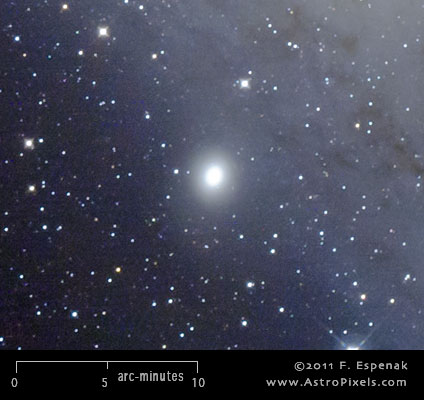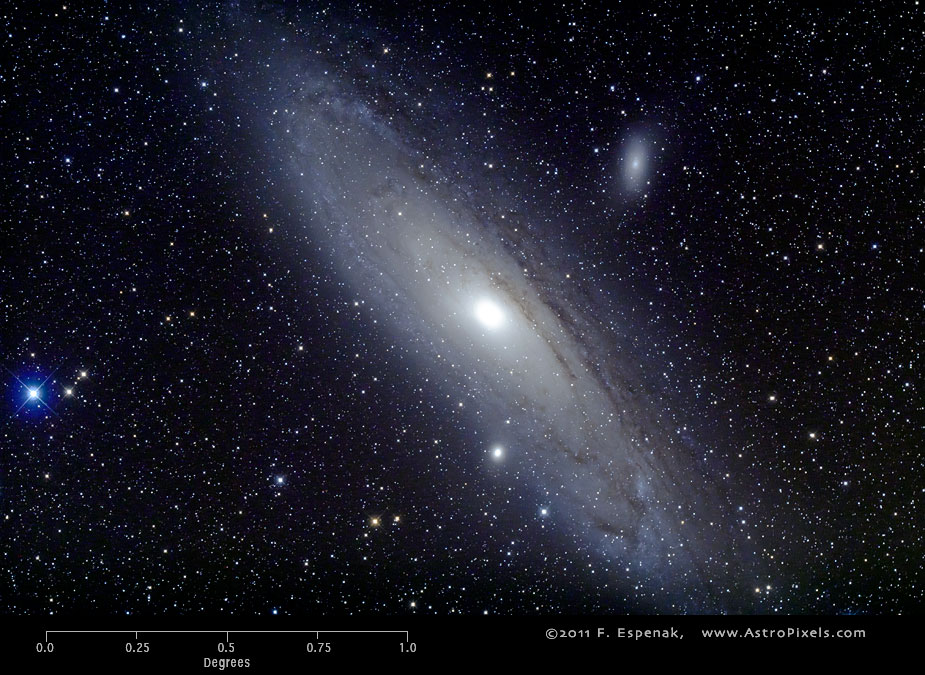
M110
Messier 110 or M110 (also designated NGC 205) is a dwarf elliptical galaxy in the constellation Andromeda. It has an apparent visual magnitude of 8.5 and its angular diameter is 17x10 arc-minutes. M110 lies at an estimated distance of 2.9 million light years. The Equinox 2000 coordinates are RA= 00h 40.4m, Dec= +41° 41´ which makes M110 best seen during the autumn. The Messier Autumn Star Chart shows the position of all Messier objects visible during that season.
M110 is one of two elliptical satellite galaxies of the Great Andromeda Galaxy (M31) visible in the image above. M32 is the closer elliptical galaxy (along the lower edge of M31) while M110 is the more distant one (upper right of M31). Great Andromeda Galaxy (M31) itself is the brightest naked-eye spiral galaxy in the sky. M31, M32 and M110 are part of the Local Group of galaxies which includes our own Milky Way Galaxy, the Triangulum Galaxy (M33) and others.
The image above shows the uncropped view of M110, M31 and M32 through the Takahashi E-180 Astrograph (North is up). A 3x enlargement of this image centered on M110 appears to the right.
This dwarf elliptical galaxy was discovered by Messier in 1773. According to Stoyan et al. (2010), the distance of M110 is 2.57 million light years and its diameter is 16,000 light years. Its estimated mass is 10 billion solar masses.
For more information, see the Messier Catalog as well as specific entries for M110 in Wikipedia and SEDS.
Messier's Description of M110
Connaissance des Tems for 1801, Paris 1798, p. 461. Also published in
Mélanges de l'Astronomie, Vol. 2, Paris 1798)
On August 10, [1773,] I examined, under a very good sky, the beautiful nebula
of the girdle of Andromeda [M31], with my achromatic
refractor, which I had made to magnify 68 times, for creating a drawing like
the one of that in Orion [M42]
(Mém. de l'acad. 1771, pag. 460).
I saw that [nebula] which C. [Citizen] Legentil discovered on October 29,
1749 [M32]. I also saw a new, fainter one, placed
north of the great [nebula], which was distant from it about 35' in right
ascension and 24' in declination. It appeared to me amazing that this faint
nebula has escaped [the discovery by] the astronomers and myself, since the
discovery of the great [nebula] by Simon Marius in 1612, because when
observing the great [nebula], the small is located in the same field
[of view] of the telescope. I will give a drawing of that remarkable nebula
in the girdle of Andromeda, with the two small which accompany it.
On a drawing of M31 and companions published 1807
`Messier 1773. Petite Nébuleuse, plus faible.'
(Small nebula, very faint.)
Technical Details
- Object: M110
- Other Names: NGC 205
- Object Type: dwarf elliptical galaxy
- Object Data: Apparent Magnitude = 8.5, Angular Size = 17x10 arc-minutes
- Object Position (Equinox 2000): RA= 00h 40.4m, Dec= +41° 41´, Constellation = Andromeda
- Date/Time: 2011 Jan 23 at 03:25 UTC
- Location: Bifrost Astronomical Observatory, Portal, AZ
- Mount: Astro-Physics 1200GTO
- Telescope: Takahashi Epsilon 180 Hyperbolic Astrograph
- Camera: Canon EOS 550D (Rebel T2i) (modified with a Baader UV/IR filter)
- Field of View: 1.70° x 2.56° at 1.7 arc-sec/pixel (web version: 10.0 arc-sec/pixel)
- Exposure: 8 x 300s, f/2.8, ISO 800
- File Name: M31-01w.jpg
- Processing (Adobe Camera Raw): Graduated Filter, Vignetting Correction, Noise Reduction, White Balance, Curves
- Processing (Photoshop CS5): Average Images, Curves, Noise Reduction
- Original Image Size: 3454 × 5179 pixels (17.9 MP); 11.5" x 17.3" @ 300 dpi
- Rights: Copyright 2011 by Fred Espenak. All Rights Reserved. See: Image Licensing.
